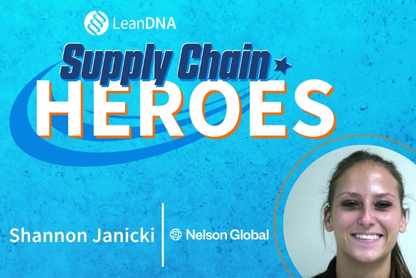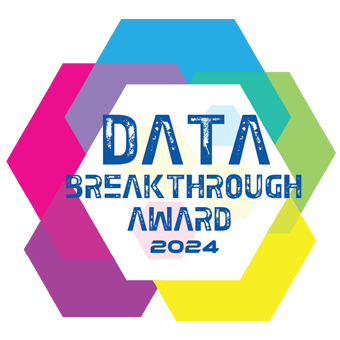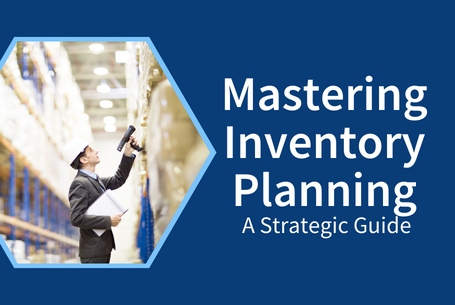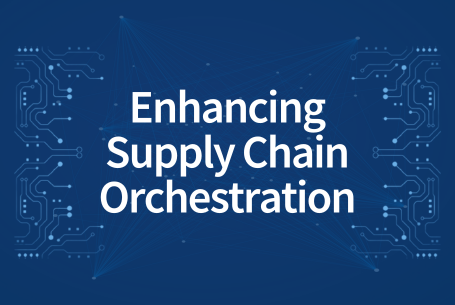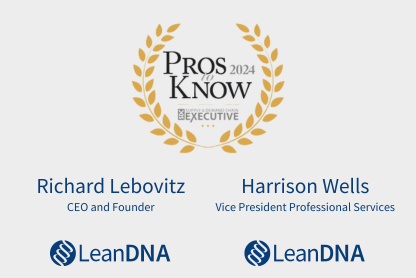A Deep Dive Into Supply Chain Insights
This is a transcript of the Supply Chain Insights podcast conducted by Lora Cecere, Founder of Supply Chain Insights, on her Straight Talk program, called Aligning Flows Across Manufacturing: An Interview with LeanDNA’s Richard Lebovitz. The podcast recording is available here.
Lora:
Welcome to Straight Talk with Supply Chain Insights, my name is Lora Cecere and I’m the Founder of Supply Chain Insights and today, I’m excited to welcome Richard Lebovitz to the Supply Chain Insights Podcast, Straight Talk. Richard is the Founder and CEO of a new and compelling supply chain analytics software company called LeanDNA. Richard, welcome to the show and tell the group a little about yourself.
Richard:
Lora, thanks for having me, I appreciate the opportunity to participate in the show. A little bit about me, I started in lean about 25 years ago with a Japanese consulting firm, and my partners worked quite early on with Toyota and Honda and at the time when I started with the firm, Lean was just really starting to get popular and I was working in many countries to drive lean conversions. As we started to work with companies to implement lean and drive this new way of manufacturing, i actually started to get very frustrated with the way the existing systems would often fight what we were trying to implement in the factory. And I’ve actually spent, through LeanDNA and my prior companies, the past 15 years, really focused on building systems and tools to help support lean factories. I found that there was a growing disconnect between the technology providers and domain experts. And we had been working for many years to provide software that can bridge this gap.
Lora:
Well, you know I’m so glad you’re doing that, because there is a great disconnect. You know you were a founder of FactoryLogic and now you’ve built this new application called LeanDNA to kind of fill in this disconnect. You know, both are based on lean principles, but they’re similar that they’re based on lean, but very different. Can you tell us a little bit about the new supply chain analytics software and also a little bit about your frustration and why you felt compelled to build the software?
Richard:
Yeah, at Factory Logic, which was my prior company that SAP acquired, we were primarily focused inside the four walls of the factory. You know there, we built sophisticated software that would help with tasks such as production leveling, kanban management, and workload balancing, but the challenge we faced was that our software required significant change management to implement. We were actually providing tools to help manage things like kanbans, but the companies were still learning what is a kan and how do we actually make it work day-to-day. After my company was acquired by SAP, I took a step back and started to focus in on how could we more quickly help companies to reduce inventory and improve delivery performance. I then started to work in many different countries, to help solve that very targeted problem, and what I found was that every company was trying to create their own solution to solve the exact same problem. These efforts were often home-grown solutions like Excel macros or BI toolkits, and then to make matters worse, these efforts could take companies months or years to implement, and in many cases they have limited success in driving real results. Then I took a step back and thought why don’t we build an out-of-the-box software that has our domain expertise built-in and specifically targets inventory reduction and shortage management through the supply chain analytics provided. Lean does a lot of different things, but if you look at what companies are really trying to achieve, it’s how do i reduce my inventory, but at the same time improve my delivery performance. And then I thought with the way technology is evolving, we can not only build something out of the box, but host it in the cloud and then deploy very quickly and on demand in a few days. Which for us, made it very easy to support alot of these companies that were working in many different countries and do it more virtually. The other piece of what I thought was evolving, and becoming much easier to do, the ability to connect to different ERP systems, that is becoming more and more prevalent. As someone that worked heavily in Lean, but also understands systems, it’s actually relatively easy to connect to these systems, but the challenge most companies have is getting the right data can be very difficult. And so now that we’ve been able to build out these powerful integrations with most ERP systems and then combine it with some pretty strong, lean principles, what we found is that we’ve been able to leverage it for a lot of companies now to go drive quicker results, but more importantly actually, make it stick.
Lora:
Well and Richard, I’m so glad you have because the primary industries you’re working with, A&D and automotive, are very focused on value networks, not necessarily the four walls, and unfortunately, those inventory levels are rising despite the adoption of lean and that’s probably some of the tension you felt. So, what’s your perspective on this and do you think your application helps here?
Richard:
Yes, in my 25 year career, I’ve seen thousands and thousands of different processes used by manufacturers to maintain and analyze their data, but most are labor intensive and involve complicated spreadsheet systems and the information is often pretty static and out of date. In the industries where we work, Lora, as you mentioned A&D and automotive, as well as some medical devices, we have seen significant success in actually implementing lean, we can see some good results. But, just addressing the physical side of lean is not enough. You have to address the system side. Some of the core strategies of lean are things like speak-with-data, perform root cause analysis, set daily goals, measure the results, you know this whole plan, do, check model. We have actually taken that lean philosophy and brought it to software where we’ve leveraged this to build an application that could be deployed quickly, drives actions and measures results. So the companies can see their levels rising, but the challenge we saw them experience is that they could see the problem but they had a really difficult time identifying the exact cause and what specific action to take to change the outcome. For example, procurement teams would get hundreds or sometimes thousands of these MRP messages every day, but what’s often missing is the ability to identify, for a buyer or analyst, what are the top five to ten actions that they can take today that will have the biggest impact on inventory or improving delivery performance. So, LeanDNA is a decision support tool that can connect to these existing ERP systems and more importantly provide specific inventory recommendations through prescriptive supply chain analytics. It can enable multi-site collaboration and then finally, track the results to make sure that what was actually recommended, is it having an effect on the bottom line.
Lora:
Well, decision support is so different than descriptive analytics, even though descriptive analytics tools like Spotfire, and Tableau and Qlikview, are cloud based often. When you think about decision support and prescriptive analytics, how do you characterize the difference, Richard, between what you're doing and some tools that others might mistakenly get confused with your approach.
Richard:
Yeah, Lora great question. These technologies are actually very helpful, that they're basically toolkits. Yes, they make it easier to visualize data, create ad hoc reports, but they lack any pre-built functionality to solve specific supply chain problems or drive actions to improve future results. The reality from my experience: supply chain leaders actually don't want to build their own technology at these big companies, but they felt they had no choice. My focus in LeanDNA is to create more of a purpose-built solution that focuses specifically on inventory reduction and helping to improve delivery performance. To actually do this and to build up this more of a decision support analytical tool versus just a BI or spreadsheet, you require specific manufacturing data model. It requires a prescriptive analytics engine with some real intelligence to it. And the last thing is it needs a very specific user workflow that can help supply chain teams perform their daily tasks. These components are what I see really differentiates us from the more traditional BI tool kits and home grown solutions that are often built upon spreadsheets or more standard databases.
Lora:
Richard from talking to your customers, I know it works. Many customers say that with MRP, they can see details but not actually see the trends in aligning manufacturing flows and many have seen an average of inventory reduction of 11%. What do you think about the technology drives this improvement when you step back and think about the evolution of your tool.
Richard:
Yes, as inventory and supply chain systems become more complex, they actually require more advanced processes to translate that data and insights to help reduce inventory and improve performance and increase efficiency. Some of the things that we talked about earlier, Lora. Embedded in our LeanDNA technology is a prescriptive analytics engine that is based on our 25 years of experience and implementing supply chain and manufacturing best practices. And it's not just my experiences, but my partners who had worked for Honda really rolling on when they were just starting lean. I was trained and learned from them and all that knowledge was built into our tool and LeandDNA automatically prioritizes and assigns daily inventory tasks that will help have the biggest impact on the business. A lot of these systems, it's almost information overload with the ERP systems and more graphs and data. People don't need more data, they need help and understanding what is the real problem, what do I need to do. And part of what we've done in LeanDNA is not only build out that workflow, but for example, in one click, we can roll up what is typically five to 10 different screens in an ERP system combined with what they may have to offline, analytically, in a spreadsheet. We do all that in one tool. With LeanDNA a procurement buyer, for example, can easily see the inventory opportunity. They can quickly understand the root cause and quickly take an action and even assign that or collaborate with other individuals. The other thing our software does is drives a standardized supply chain best practices to not only make recommendations but track the results. For example, we found that there's a close-looped control, which is based on that lean methodology that I talked about earlier, follows this plan-do-check-act to help drive more accountability. Our software also enables cross site prescriptive analytics where the data can be analyzed across sites, using different instances of SAP for example, or Oracle, or in many cases are in totally different ERP systems. We can bring that information together to help reduce shortages, to help identify excess at one site that could be used in another site. We also find that a lot of the supplier information or master data, there's not an easy way to compare that information and we can do all that in LeanDNA, so part of our success, to your original question, or about the 11%, is the ability to make the standard work easier for buyers and analysts. Part of it is making it easy for buyers day-to-day to use LeanDNA, have value, tell them what to do. We also find that the level above them, like the supply chain managers, they like it because it gives them visibility and attracts the performance of their team and they can go identify what buyer they can usually see it. And then finally the executives like it because it's helping them drive results. In some ways, the big part of achieving inventory results is because we've created technology that is rather powerful on the back end, but easy for people to understand and use on the front end.
Lora:
So Richard, a lot of people that are listening or thinking about SAP's launch at DDMRP, and they might get this confused with that approach. DDMRP actually translates material requirements and looks at buffer flows, but really more within the enterprise. How do you contrast the difference or do you have any thoughts in this area.
Richard:
Well, in fact, Lora, DDMRP was something that you brought to our attention. I hadn't actually heard of it before, but in starting to learn a little bit more about it, I think that we would actually complement DDMRP. Similar to Lean, DDMRP is more of a strategy than it is an analytical system or decision support tool. To implement DDMRP, for example, you need to do things like establish the right order policy; you need to size the correct parameters, and then once you get that right, you need to make sure people are actually complying with following those methodologies or sizing that are in the MRP system. In my view, LeanDNA can provide the supply chain analytics actually to support DDMRP implementation. So in a way, we're very complementary to it in a way that we do complement other aspects of ERP systems when it comes to setting the right parameters and helping to drive day-to-day execution, and then measuring results.
Lora:
Well, Richard, a lot going on. I'm glad to have you back in the software industry. I was disappointed when you sold your other company 'cause I thought you were doing some great things. And I know a lot of people are looking for lean enablement. So let's just wrap up. What words of wisdom do you have for people that are out there that are working on lean, thinking about materials, or assemble to order or make to order kind of industries? Any words of wisdom to close the show today.
Richard:
Yeah, yeah, definitely learned a lot more over the last many years of doing this and I see what we do at LeanDNA as bringing together the world of Lean and supply chain and manufacturing domain expertise, plus the world of systems and technology plus the cloud. Looking back, I would say, even only 10 years ago, I think we could have easily managed some of the supply chain topics we discussed today with some well written macros in excel, but with the increasing complexity of products, more customization, the supply chains that become much more global and outsourced, there is multiple sources of data now. This ability to manage it through Excel is no longer possible, in my opinion. If we can not identify and react to issues within hours today, we may lose the opportunity to actually make an impact and take action. If we can't make complicated technology easy to use, no matter the potential, it may never be used by people day to day to drive improvement activity in daily work. We are excited about the potential to bring together the areas of artificial intelligence and machine learning, cloud computing, lean strategies, the advancements of user interfaces where before, there would be a lot of training now it's... well, I wanna be able to just log in and use it and that’s methodology that people want to just follow. And bringing those components altogether in one system and being able to have a measurable impact with some of the largest manufacturing companies, the role we have, we're pretty excited about the possibilities and not only what we can do, but the way technology can be leveraged for factories and supply chains in the future. And I would thank you, Lora, for the opportunity to participate in your show, and we're excited to hopefully share some of our thoughts and future goals with some of the listeners out there that listen to you.
Lora:
Great. Well, Richard, thank you for joining the show. As always. We're always excited to talk to innovators. 90% of supply chain results are stuck at most companies and it's because I think we've been trying to do the same old thing with yesterday's solutions. Richard, welcome back to the software market and thanks for joining the show. Until next time, this is Lora Cecere, with Supply Chain Insights bringing you Straight Talk with Supply Chain Insights. Take care of Richard.
Richard:
Thank you.


